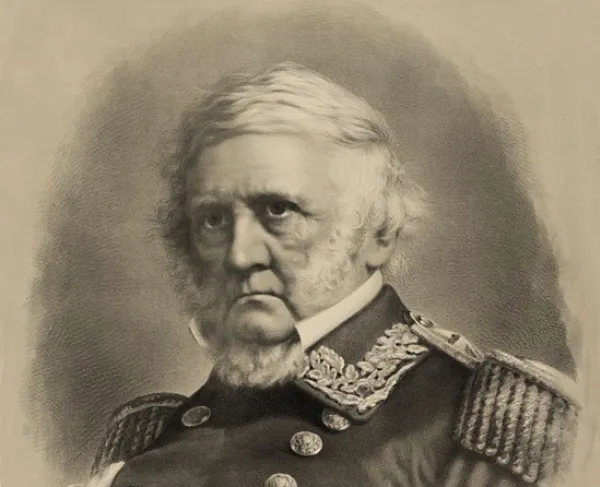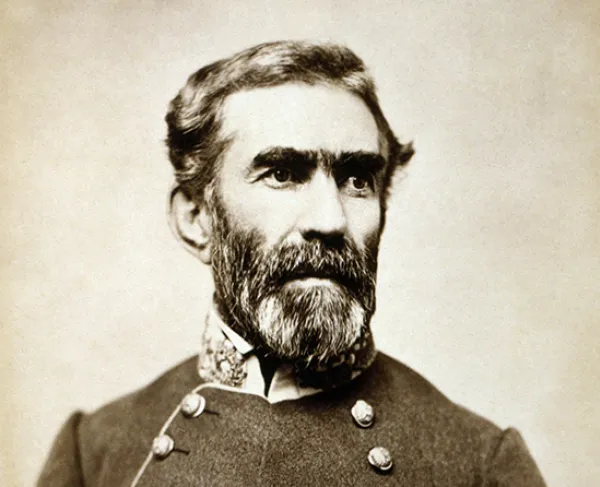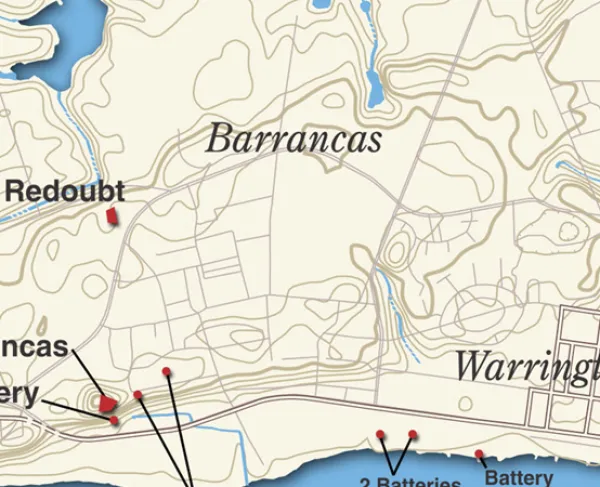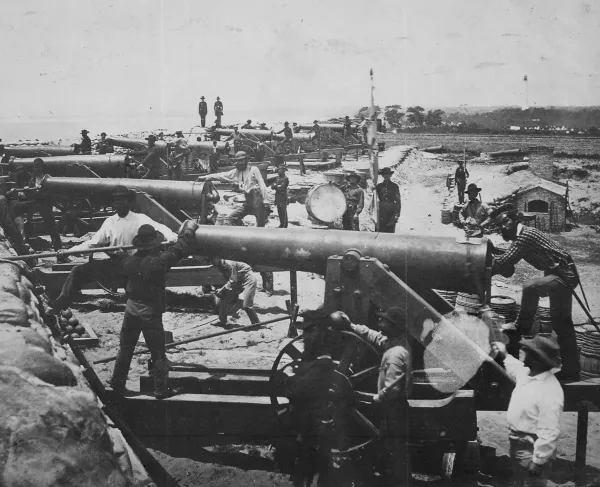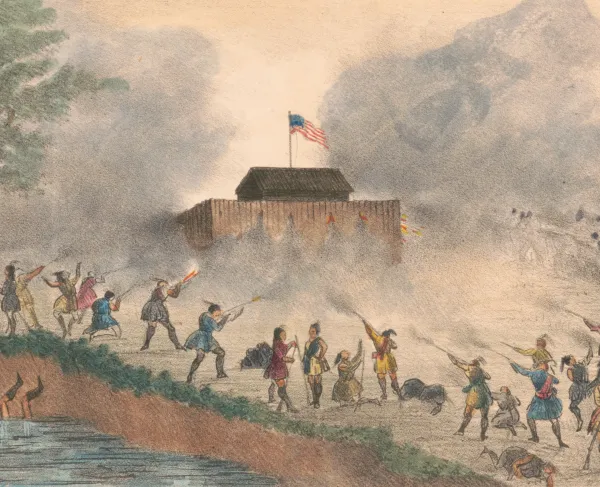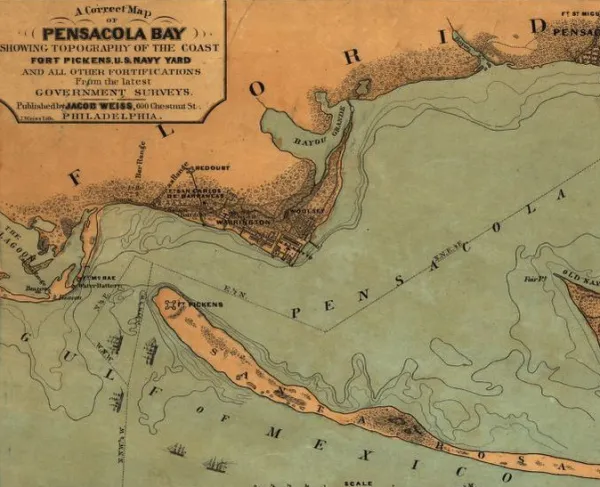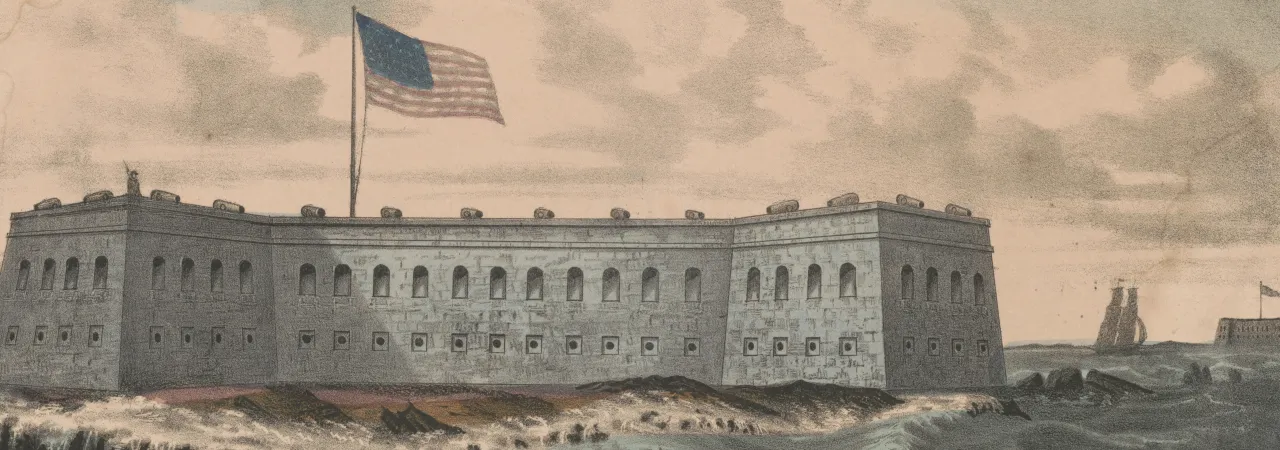
"Fort Pickens: Pensacola Harbor, Florida" by Currier & Ives. 1860-1870.
Pensacola (1861)
Pensacola, Florida | Jan 8, 1861 - May 10, 1862
The Battle of Pensacola started on January 8, 1861, in Pensacola Bay, Florida following an attempted secessionist takeover of Fort Barrancas. Over the next year, Union and Confederate soldiers fought for control of the city in the Battle of Santa Rosa Island and Battle of Fort McRee until May of 1862 when Confederates left to defend the area surrounding New Orleans, Louisiana after Union troops successfully captured the city. Union soldiers then took control of the town and used the region as a base of operations for campaigns until 1863 in the Vicksburg Campaign.
During the Secession of the Lower South in the winter of 1860-61, the United States Army stationed at Federal forts along the Gulf Coast, as well as civilians in the surrounding localities, were on edge. In Pensacola Bay, there laid three forts: Fort Pickens, Fort McRee, and Fort Barrancas. Each fort kept watch over the Pensacola Harbor. On the eve of secession, both Union and Confederate wanted to possess the three forts in order to maintain control of the Gulf of Mexico. On January 8, 1861, just two days before Florida's secession from the Union, Floridian state militia led by Colonel WIlliam Chase demanded that U.S. soldiers stationed in Fort Barrancas to surrender. U.S. soldiers fired warning shots at the Florida militia, deterring them from taking the fort. U.S. command at Fort Barrancas, however, believed Fort Barrancas to be an untenable position, and quietly moved to Fort Pickens on January 10, 1861. Before moving, U.S. command, led by Adam Slemmer, had the fort's cannons spiked. U.S. soldiers stationed at Fort McRee also moved to Fort Pickens after spiking their cannons and dumping all of their gunpowder into Pensacola Bay. In response, Florida state militias took Forts Barrancas and Fort McRee, thus beginning a year-long campaign between federal and Confederate forces hoping to both defend the upper panhandle of the Sunshine State.
Over the next several months, U.S. and Florida state militia remained at odds with one another. In late January of 1861, the men garrisoned at the forts agreed not to fire on one another as long as Fort Pickens was not reinforced. When President Abraham Lincoln took office on March 4, 1861, however, Lincoln decided to disregard the agreement, and had the USS Brooklyn land soldiers to reinforce Fort Pickens on March 12, 1861. Additional Union troops arrived at Fort Pickens on April 16 from the USS Atlantic.
On March 11, Confederate General Braxton Bragg arrived in Pensacola and took command of Fort Barrancas and Fort McRee. Establishing his headquarters at Fort Barrancas, Bragg requested an additional 5,000 soldiers from Alabama, Louisiana, Georgia, and Florida. By mid-April, Bragg amassed a force of 5,000. After Union soldiers landed additional soldiers in mid-April, Bragg declared martial law in Pensacola.
By the summer of 1861, Confederate President Jefferson Davis hoped that a yellow fever epidemic would break out among the ranks of Union soldiers. However, this epidemic never materialized, and the Union soldiers remained strong at Fort Pickens. On May 25, President Lincoln sent additional soldiers to Pensacola on the steam frigate Niagara under the command of Captain William McKean. In late June, the 6th New York Volunteers arrived at Pensacola.
Decisive action did not come around until September of 1861. On September 2, Union sailors burned the Confederate ship Judah, and spiked local cannons in the Pensacola Navy Yard. The engagement resulted in three Union soldiers killed and thirteen wounded.
In a retaliatory attack for the burning of the Judah, Confederate forces led under Braxton Bragg launched a surprise attack on Santa Rosa Island on October 9. Under the cover of the night on October 8, Confederate landed four miles east of Fort Pickens. Approximately 1,000 Confederate soldiers engaged the men of the 6th New York, who put up a brief fight before retreating towards Fort Pickens. When dawn broke, the Confederates lost the element of surprise, and retreated while being fired upon by the defenders of Fort Pickens. Known as the Battle of Santa Rosa Island, the engagement cost the Union 67 casualties and the Confederates 87 casualties.
In late November of 1861, Union gunships and Fort Pickens bombarded Fort McRee. The Confederates fired back, which led to an artillery duel that lasted for over eight hours. While Fort McRee was heavily damaged, there were minimal casualties on both sides. Into the winter of 1862, Braxton Bragg realized that the Union Army had faired better than at Pensacola. The capture of Forts Henry and Donelson in February of 1862, and the capture of New Orleans pressured Bragg to take the fight to the Union elsewhere. In February of 1862, Confederate Secretarynof War Judah Benjamin instructed Bragg to send his troops to Tennessee, and Bragg himself was transferred to Mobile, Alabama. Pensacola, however, was taken command by General Samuel Jones. On May 9, 1862, Confederate forces left Pensacola, in a blaze. Confederate cavalry leaving Pensacola burned storehouses, an oil factory, and boats. The following morning, on May 10, 1862, Union soldiers took control of Pensacola, ending the year-long engagement.
67
87
Following the year-long campaign at Pensacola, the Union Army continued to be a force to be reckoned with in the West. Continued progress in the West led to Union victories at the Battle of Shiloh, Siege of Vicksburg and the Battle of Stones River, all battles that started in 1862. In Pensacola, however, the Union Navy established a base of operations in the area and used the sites to launch operations into Western Florida, Alabama, and Mississippi. Over the course of the Civil War, Pensacola became obsolete as the military focus of the Union shifted further west in the Mississippi River. However, the Union occupied the Pensacola region until the end of the Civil War.
Pensacola (1861): Featured Resources
All battles of the Western Theater Campaign
Related Battles
2,000
7,000
67
87
